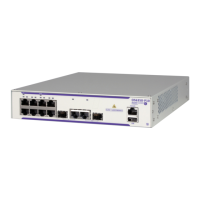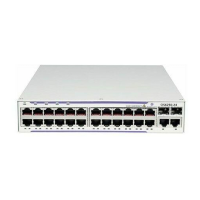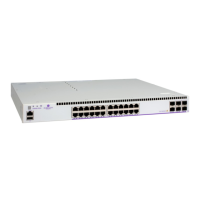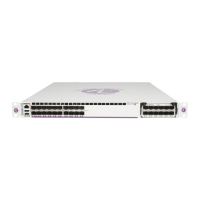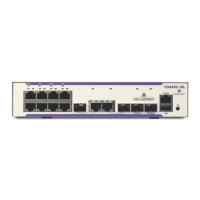Configuring 802.1AB 802.1AB Overview
OmniSwitch AOS Release 8 Network Configuration Guide December 2017 page 13-5
IEEE 802.1 Organizationally Specific TLV Set
• Port VLAN ID TLV
• Port and Protocol VLAN ID TLV
• VLAN name TLV
• Protocol identity TLV
IEEE 802.3 Organizationally Specific TLV Set
• MAC/PHY configuration/status TLV
• Power through MDI TLV (in network connectivity TLV set, Extended Power-through-MDI TLV is
supported)
• Link Aggregation TLV
• Maximum frame size TLV
ANSI-TIA LLDP-MED TLV Sets
• Network connectivity TLV set
• LLDP-MED capabilities TLV
• Inventory Management TLV
• Location Identification TLV
• Extended Power-through-MDI TLV
When an 802.1AB supporting system receives an LLDPDU containing MED capability TLV, then the
remote device is identified as an edge device , for example, IP phone and IP PBX, among others. In such a
case, the switch stops sending LLDPDU and starts sending MED LLDPDU on the port connected to the
edge device.
LLDP-Media Endpoint Devices
LLDP-MED is an extension to 802.1ab (Link Layer Discovery Protocol - LLDP), a link-layer protocol
that defines a method for network access devices using Ethernet connectivity to advertise device
information, device capabilities and media specific configuration information periodically to peer devices
attached to the same network.
The LLDP-MED feature facilitates the information sharing between Media Endpoint Devices and
Network Infrastructure Devices. It is designed to allow the following functionalities:
• Auto-discovery of LAN policies (such as VLAN, Layer 2 Priority and Diffserv settings) leading to
"plug and play" networking. This is achieved by advertising the VLAN information.
• Device location discovery to allow creation of location databases for VoIP, E911 services.
• Extended and automated power management of Power-over-Ethernet endpoints.
Note. If one TLV from this set is included in the LLDPDU, then all the other TLVs need to be included.

